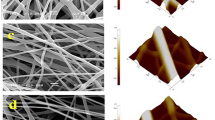Abstract
A methodology for the preparation of porous scaffolds for tissue engineering using co-extrusion is presented. Poly(ε-caprolactone) is blended with poly(ethylene oxide) in a twin-screw extruder to form a two-phase material with micrometer-sized domains. Selective dissolution of the poly(ethylene oxide) with water results in a porous material. This method of polymer extrusion permits the preparation of scaffolds having continuous void space and controlled characteristic length scales without the use of potentially toxic organic solvents. A range of blend volume fractions results in co-continuous networks of polymer and void spaces. Annealing studies demonstrate that the characteristic pore size may be increased to larger than 100 μm. The mechanical properties of the scaffolds are characterized by a compressive modulus on the order of 1 MPa at low strains and approximately 10 MPa at higher strains. The results of osteoblast seeding suggest it is possible to use co-extrusion to prepare polymer scaffolds without the introduction of toxic contaminants.
Similar content being viewed by others
References
Ch. Schugens, V. Maquet, C. Grandfils, R. Jerome and Ph. Teyssie, Polymer 37, 1027–1038 (1996).
K. Whang, C. H. Thomas, K. E. Healy and G. Nuber, Polymer 36, 837–842 (1995).
J. H. Aubert and R. L. Clough, Polymer 26, 2047–2055 (1985).
Ch. Schugens, V. Maquet, Ch. Grandfils, R. Jerome and Ph. Teyssie, J. Biomed. Mater. Res. 30, 449–461 (1996).
Ch. Schugens, Ch. Grandfils, R. Jerome, Ph. Teyssie, P. Delree, D. Martin, B. Malgrange and G. Moonen, J. Biomed. Mater. Res. 29, 1349–1362 (1995).
V. Maquet and R. Jerome, Mater. Sci. Forum 250, 15–42 (1997).
N. R. Washburn, C. G. Simon, A. Tona, H. M. Elgendy, A. Karim and E. J. Amis, submitted.
Certain equipment and instruments or materials are identified in the paper to adequately specify the experimental details. Such identification does not imply recommendation by the National Institute of Standards and Technology, nor does it imply the materials are necessarily the best available for the purpose.
C. W. Macosko, Rheology: principles, measurements, and applications (VCH Publishers, Inc., New York, 1994).
M.A. Attawia, K.E. Uhrich, E. Botchwey, R. Langer and C. T. Laurencin, J. Orthop. Res. 14, 445–454 (1996).
R. C. Thomson, M. J. Yaszemski and A. G. Mikos, in Principles of Tissue Engineering, edited by R. P. Lanza, R. Langer, and W. L. Chick (Academic Press, San Diego, CA, 1997), pp. 263–272.
Author information
Authors and Affiliations
Rights and permissions
About this article
Cite this article
Washburn, N.R., Carl, G., Karim, A. et al. Development of Biodegradable Polymer Scaffolds using Co-Extrusion. MRS Online Proceedings Library 662, 16 (2000). https://doi.org/10.1557/PROC-662-LL1.6
Published:
DOI: https://doi.org/10.1557/PROC-662-LL1.6




